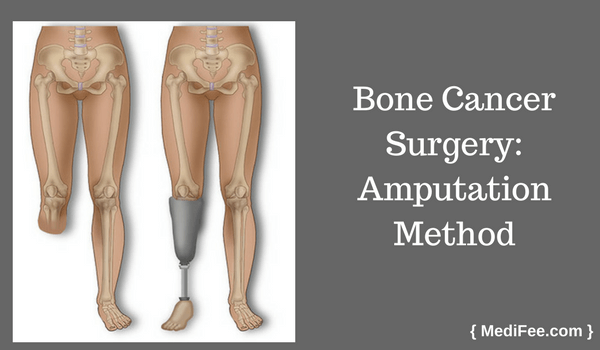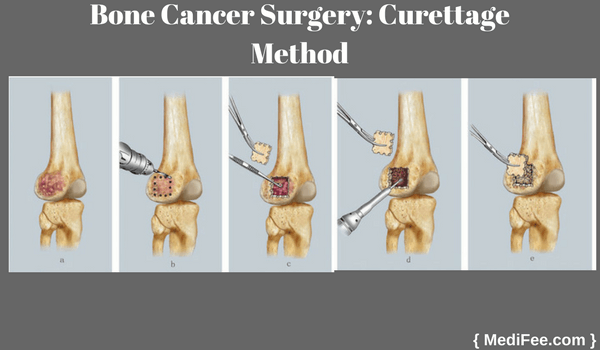Bone Cancer Surgery
Listed below is the step by step procedure of bone cancer surgery:
- What is Bone Cancer Surgery?
- Why is Bone Cancer Surgery Required?
- Pre-operative Preparation
- Day Before Surgery
- Procedure Day
- Methods/Techniques of Bone Cancer Surgery
- Post Procedure
- Risks and Complications
What is Bone Cancer Surgery?
Bone cancer surgery is one of the main treatments for cure of primary bone cancers. This surgery involves removal of cancerous tumors. Sometimes, a part of bone or complete bone can be removed by surgery. It is a specialized treatment which needs to be carried out by an experienced orthopedic oncologist.

After removal of cancerous cells, surgeon may remove a margin of healthy tissue surrounding the bones affected by cancer. This is sent to the laboratory for confirmation of complete removal of cancer. Once it is confirmed, the prosthesis is fixed in the place. Prosthesis is an implant or artificial part for replacement of bone removed by the surgical process.
Why is Bone Cancer Surgery Required?
For removal of affected area and prevention of further serious complications, bone cancer surgery is recommended. Patients who are not getting desired results with medicinal treatments, surgical option is preferred. In some cases, chemotherapy and radiation therapy treatments are also advised along with surgical methods. Most of the times, surgeons will try to save body parts affected by cancer instead of direct removal. In cases where cancer has spread out of control and risk of spread to other body parts is high, surgical treatments are must. Care is taken to ensure that less amount of healthy tissue is removed with the help of special surgical techniques. Some dramatically advanced techniques are helpful in preventing complete removal of legs or arms and focus on affected area itself. This reduces burden on the minds of the cancer patients.
Stages of Bone cancer
TNM staging system is used for staging bone cancer. TNM stands for:
- Tumor (T): Size of primary tumor, location of tumor
- Node (N): Detection of cancer spread to the lymph node
- Metastasis (M): Detection of location, occurrence and frequency of metastasis of cancer
Pre-operative Preparation
Prior to bone cancer surgery, some tests need to be performed to ensure good health of the patient. These tests are given below.
- Bone scan
- MRI scan
- CT scan
- Blood tests
- X-ray of chest
- ECG: electorocardiogram
- ECHO: echocardiogram
- Breathing tests
Some of these imaging tests might have been done already for diagnostic purpose. In such cases, no repetition of tests is required.
Breathing tests are of great importance prior to the surgery as they indicate recovery capacity from the health status of lungs. A nurse or physiotherapist can give training of breathing and leg exercises. This helps post surgery when movements are not easy to make. Also, leg exercises help in preventing the formation of blood clots in the legs. These experiences need to be done as per surgeon's advise. As there will be problems in movements post surgery, exercise prior to surgery may help in early recovery.
Basic physical examination, symptoms and diagnostic test results detect the presence of bone cancer. Typically, a biopsy sample is required to be collected for confirmation of bone cancer. Sometimes, bone metastasis can be confused with bone cancer due to similarity in the symptoms. This is why, a biopsy is required to be carried out.
Day Before Surgery
A day before surgery, all reports of diagnostic and blood tests need to be organized and kept in the operation theater as supporting documents during surgical process. Medications and other requirements for surgical method need to be checked as well for avoiding last minute issues. Patients are advised to follow instructions of doctors on the day prior to surgery. These instructions include food to be consumed and such other things. Remember that failing to follow instructions can lead to complications.
Procedure Day
On the day of surgery, patient needs to maintain hygiene for prevention of contamination and complications. No food intake prior to few hours of surgery is allowed. Brief idea about the surgery and outputs will be given to the patient and close relatives. Patient is taken to the operation room and draped in sterile clothing. An anesthesia is given to the patient prior to the surgery.. There are different ways in which surgery can be performed based on the specific condition of patient. Mentioned below are the various ways used for performing surgery.
Methods/Techniques of Bone Cancer Surgery
Various types of bone cancer surgeries can be performed, based on the location and cancer spread extent.
Limb Salvage Surgerys
The main objective of limb-salvage surgery is saving the limb in approximately 90% of cases. During this surgery, removal of bone cancer along with some healthy surrounding tissue is carried out. Enough bone is left for saving the arm or leg of the patient. Bone graft or an endoprosthesis is used to fill the space from which bone has been removed. A rehabilitation program is often recommended to these patients for maintaining the functioning of arm or leg on which surgery was performed.
Amputation
Surgical removal of limb corresponding to the cancerous bone is removed. There may be removal of complete or part of the limb. Post-surgery, an artificial prosthesis i.e. an artificial limb, is atatched to amputated end of the operated limb. It has been reported that an amputation was the major choice of treatment for bone cancer sufferers previously.

But as per advances in surgery methods, limb saving techniques have been developed. These days, amputation surgical methods are used only in cases where essential nerves, muscles or arteries are damaged and cancerous growth must be removed.
Bone Cancer Surgery in Other Areas (Apart from Arm and Leg)

Bone cancers can occur in many areas of the body. Scrapping of cancerous cells is carried out during bone cancer surgeries for skull and spine instead of complete bone removal. This process is known as curettage. Different techniques can be used for removal of cancerous tissues and the space is filled after surgical process. Liquid nitrogen can be used post-surgery in this case. This helps in killing the remaining cancerous cells. For filling the holes in the bones, bone cement or bone grafts are used.
Post Procedure
A blood pressure cuff can be found on the arm of the patient after waking up post surgery. In first few hours after surgery, blood pressure is measured once the patient comes out of anesthesia. A pulse oximeter in the form of little clip is fitted on the finger for measurement of pulse and blood oxygen level. Sometimes, an oxygen mask can be used for a while. Measurement of urine output is also carried out for getting an idea about quantity of fluids consumed. This helps in prevention of excess fluid intake as well as dehydration. Electronic pumps attached are used for giving painkillers, antibiotics and medicines required after surgical process for recovery.
Along with all those mentioned above, there are some more external aspects that can be attached as follows:
- Spinal anesthetic:
A thin tube for giving painkillers into the fluid surrounding spinal cord.
- Intravenous infusions:
For supplying blood and fluids until the patient is able to eat and drink post surgery.
- Catheter:
A tube to be inserted in the bladder for passing the urine until the patient starts moving post surgery.
- Drains from the wound:
These drain tubes are required for draining blood and tissue from the surroundings of site of operation.
- Painkillers:
For the first week or so, patients can experience pain post surgery. It is possible to get the pain under control with the help of painkillers. Patients need to inform the surgeon about the severity of pain. Based on that, dosage of painkillers is decided. This helps in early recovery of pain symptoms post surgery. Sometimes, a hand control button is provided for pain reporting. Patients can press the button whenever pain is more and extra painkillers are required to be given. This is patient controlled analgesia (PCA). In some cases, local anesthetics or painkillers are given directly into the arm or leg nerves which were under operation.
Phantom pain is experienced in case of patients where an arm or a leg is removed by bone cancer surgery. It gets reduced with time and can be controlled. Phantom pain is the feeling of pain in an arm or a leg which is not present as a result of removal during surgery
- Wound Healing:
Post operation, patients find their wound covered. This covering can be removed after few days for cleaning the wound. Stitches will be kept for at least 10 days post operation. A waterproof cover can be used in some cases. Covers can be used for operated body part while having shower or bath.
- Prosthesis After Limb Removal:
Once part of body affected by bone cancer is removed by surgery, complete healing needs to happen prior to prosthesis. Since area surrounding the wound is swollen, false or artificial limb may not fit properly which is why, complete recovery of part under operation is required.
- Physiotherapy:
Physiotherapist helps the patients post surgery when movements are not easy to make. Caring for skin is advised which helps in preventing damage and soreness. In case of children, as they grow, new artificial limbs are required to be implanted. It is a time consuming recovery precess. It may take months to get comfortable with an artificial limb.
Risks and Complications
Typically cancerous tissues are removed from the location of cancer during bone cancer surgery. Briefed below are the complications associated with bone cancer surgery:
- Shock:
During surgery, blood pressure can drop below normal ranges which leads to shock.
- Amputation:
For advanced stage bone cancers, surgeon may carry out amputation of cancer affected arm or leg.
- Wound infection:
Entire body of the cancer patient can get infected from the entry of bacteria through incisions. This makes bone cancer patient sick and healing process gets slower.
- Hemorrhage
An uncontrollable bleeding can occur from the site of surgery. This increases possibility of shock in bone cancer patients.
To conclude with, it is very essential to treat cancer patients with extra care at last stages. They are in need of love and affection from close family members as well from care takers. Post surgery and especially after recurrence of bone cancer, it is not easy to survive. To cope up with end-stage cancer, a strong will power is required as well. There are miraculous recoveries of cancer patients only as a result of strong will power. A timely and recommended treatment plays its role obviously. Well trained surgeons and early diagnosis is helpful in prevention of complications associated with bone cancer.
More information related to Bone Cancer surgery
Best Orthopedic Surgeons in India
Top Orthopedic Hospitals in India

